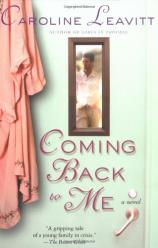Reading Group Guide
Discussion Questions
Coming Back to Me

1. Coming Back To Me begins with a preface, which unlike the rest of the book, is written in the present tense. Why do you think Leavitt chose to do that? What effect does the present tense create? Why do you think Leavitt started the book in the middle of the story and then backtracked to an earlier, happier time? What effect does that have? How would the book have been different if it was told in a linear fashion?
2. Coming Back To Me deals a lot with the issue of community and the families we form, and how those families can ruin or protect us. Gary and Molly are drawn together because they both feel orphaned. When they move into New Jersey, they find a hardscrabble, tightly-knit community that perceives them as outsiders, which makes Gary and Molly so uncomfortable that they draw even closer together. What do you think Leavitt is saying about the notion of community? How and why does this notion change throughout the book?
3. On page 301, Gary thinks: "Events didn't always turn out the way you hoped they would. But the thing was that sometimes people came through. The most unexpected people in the most unexpected ways." Who were the unexpected people for Gary and how did they help? Why do you think this was this so surprising for Gary? Do you think his having been an orphan colored his thoughts on how things turn out in life?
4. Throughout the book, there runs the theme of people trying to keep safe. How do each of the major characters; Suzanne, Molly and Gary each handle this? How are each able to succeed-or fail? Why do you think Leavitt added a section revolving around the baby's safety? How does the baby's section differ from those of the other characters-and why?
5. Coming Back To Me focuses on the struggle between sisters. Why is it important that Suzanne and Molly start out being really close and loving? How does the conflict between the two sisters evolve? While Molly doesn't feel at fault, Leavitt indicates certain things that Molly does, which push Suzanne away. Could there have been another, better way for Molly to handle things with her sister?
6. Memory plays a large part in this novel. A cornerstone of the book is the two memories of the same event: Molly's version and Suzanne's version of the time when Suzanne ran away from home with her boyfriend Ivan and how and why it affected the family, especially the relationship between the sisters. Why do you think Leavitt gave us two versions of the same incident? How do both versions differ? Which version do you think is the correct one? What do you think this says about memory?
7. Memory-or the lack of it-crops up again, when Molly is in the hospital and has been given memory blockers and can't remember seeing her family at all. How does this event resonate with the theme of memory? What do you think Leavitt is trying to say about how and what and why we remember what we do? Are there ever things these characters-or people in general--need to forget?
8. Molly and Suzanne both had a missing-in-action mother, a woman who was there, but was more intent of finding a husband then attending to her daughter's needs. When Molly gives birth, to her horror, she also is a missing mother to her baby, whom she's not allowed to see. Why do you think Leavitt made Molly a missing-in-action mother, too? What is the significance of the way Molly finally bonds with baby Otis?
9. Coming Back To Me is told from the perspectives of three different people. Why do you think Leavitt did that? How would the book be different if it was told by just Gary? Or by just Suzanne?
10. Why do you think Leavitt ended the book on an ambiguous note? Why is the last section set in the fall and at Halloween where people are wearing costumes? Why do you think Molly uses the phrase "right now" twice? What do you think this says about destiny and fate and our ability to plan for the future-and why is this hopeful?
Coming Back to Me
- Publication Date: September 1, 2003
- Genres: Fiction
- Paperback: 320 pages
- Publisher: St. Martin's Griffin
- ISBN-10: 0312305540
- ISBN-13: 9780312305543








